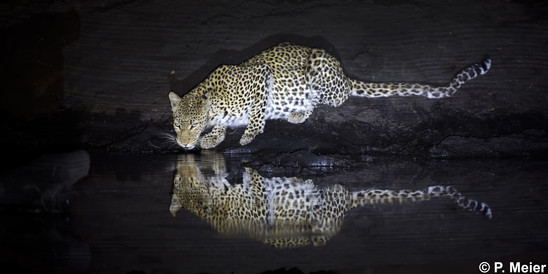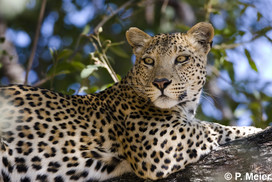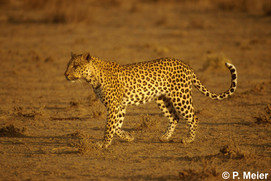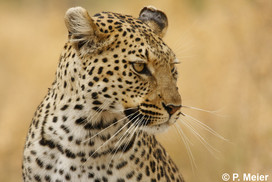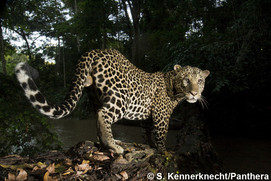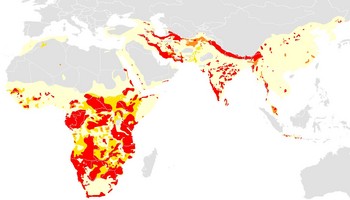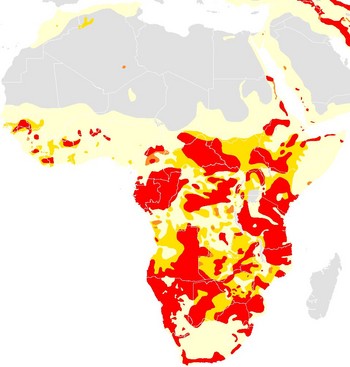Leopard
Panthera pardus
IUCN Red List: Vulnerable

| Weight: | 17-90 kg |
| Body length: | 91-191 cm |
| Tail length: | 51-101 cm |
| Longevity: | 13-21 years |
| Litter size: | 1-4 cubs |
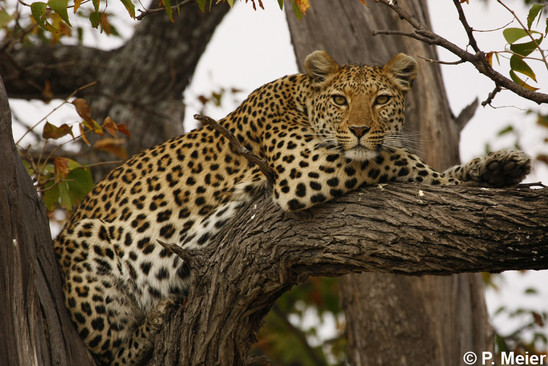
Description
Previously nine leopard (Panthera pardus) subspecies were described:
- African leopard P. p. pardus occurring in Africa
- Arabian leopard P. p. nimr inhabiting Arabia
- Persian leopard P. p. saxicolor from Central Asia
- Javan leopard P. p. melas occurring in Java
- Sri Lankan leopard P. p. kotiya from Sri Lanka
- Indian leopard P. p. fusca inhabiting the Indian subcontinent
- Indochinese leopard P. p. delacouri occurring from southeast Asia into southern China
- North China leopard P. p. japonensis from northern China and
- Amur leopard P. p. orientalis described from the Russian Far East, Korean peninsula and northeastern China.H
However, based on more recent genetic studies, only eight leopard subspecies are proposed:
- Panthera pardus pardus in Africa
- Panthera pardus tulliana, including cicsaucasica and saxicolor, in Turkey, Caucasus, Turkmenistan, Uzbekistan, Iran, Iraq, Afghanistan and Pakistan
- Panthera pardus fusca in India
- Panthera pardus kotiya in Sri Lanka
- Panthera pardus delacouri in South-East Asia and probably southern China
- Panthera pardus orientalis, including japonensis, in Eastern Asia from the Russian Far East to China
- Panthera pardus melas on Java and
- Panthera pardus nimr on the Arabian Peninsula
More sampling throughout the leopard's range and analyses are needed to clarify the number of subspecies as some results for example indicate that all Asian subspecies, excluding melas, possibly form one single subspecies.
There is a high degree of variation in size and colouring of leopards across their broad geographical range. Leopards in Africa are typically the largest and can weigh up to 90kg; but also in the mountains of Iran and Central Asia they can attain large sizes. Usually, the leopard’s fur is yellowish to olive and black spotted overall with individually unique patterns. In Africa, melanistic individuals are rare but in humid forest habitats as in Java and Malaysia melanism is more common. The colour and patterns of the leopard’s fur seem to be associated with habitat type. For example, in Africa the leopards inhabiting the savannah have a rufous to ochraceous colour, leopards in deserts are paler to yellow–brown in colour with a more greyish colour in cooler areas. Individuals from the rainforests are darker and have a golden colour while leopards inhabiting high mountains are even darker than the ones from the rainforests.
The leopard has very muscular and relatively short legs with broad paws. It has a long body and tail which helps in tree climbing. The sexes show marked differences in size and physical features which indicates different feeding ecology. Despite its relatively small body size, the leopard is still capable of taking large prey. Its skull is massive, giving ample room for the attachment of powerful jaw muscles. Its whiskers are particularly long and there are often several extra-long hairs in the eyebrows, protecting the eyes and assisting movement through vegetation in darkness. Its scapula is adapted for the attachment of powerful muscles that raise the thorax, enhancing its ability to climb trees. The leopard can live independent of water for periods of time, satifying moisture requirements entirely from prey.
Language/Country | Name |
|---|---|
Botswana (Ju/hoan Bushman, Setswana) | !'Hom, sinkwe z inqwe |
Democratic Republic of the Congo (Mbuti, Pygmy dialects) | Mabilanga, moli, ka'u |
English | panther |
Ethiopia (Amharic) | nebr |
French | léopard, panthère |
Gabon (Kota, Fang, Kwele) | ngoye, nze, goye |
German | Leopard, Panther |
Kenya (Luo, Maasai) | kwach, oluwaru keri |
Kishwahili | chui |
Namibia (Ju/hoan Bushman) | !'Hom |
Nigeria (Ibo, Yoruba) | eduka, ekun, ogidan |
Somalia | shabeel |
Spanish | leopardo, pantera |
Tanzania (Maasai) | oluwaru keri |
Uganda (Luo) | kwach |
West Africa (Hausa) | damissa |
Status and Distribution
The leopard is considered as Vulnerable in the IUCN Red List. It is widely distributed across Africa and Asia and in some areas of Africa and tropical Asia the leopard is quite common. However, its populations have decreased and got isolated in many regions and the leopard vanished from large parts of its historic range. Mainly across North, East and West Africa, the Middle East, East and South-east Asia, the species highly declined and got regionally extinct due to habitat loss and fragmentation, prey loss and poaching for the illegal wildlife trade. In North Africa, the leopard is on the verge of extinction. It has lost around 97% of its former range and only remnant, isolated populations persist. The previously confirmed populations in Morocco and Algeria may have vanished. Throughout much of West Africa, the leopard has become rare; it has completely disappeared from parts of the Western Sahel. Leopards are now restricted to a few protected areas from Senegal to Nigeria. In Central Africa leopard range is mainly reduced in areas of high human activity and also leopard populations in East Africa have been reduced. Neither in South Africa, its stronghold, the leopard seems to have stayed stable. Leopard populations in Angola, Zambia, Mozambique and Zimbabwe seem to be decreasing and leopards to be disappearing from areas with increased development and intensive conflict with humans. The leopard is now possibly exinct in Gambia, Israel, Korea, Lao PDR, Lesotho, Tajikistan and Viet Nam and regionally extinct in Jordan, Kuwait, Lebanon, Mauritania, Morocco, Singapore, Syria, Togo, Tunisia, United Arab Emirates and Uzbekistan.
Subspecies | estimated population size |
|---|---|
Amur leopard | <60 |
Arabian leopard | 45-200 |
Javan leopard | <250 |
Sri Lankan leopard | 700-950 |
Persian leopard | 800-1,000 |
North China Leopard | <500, subpopulations <50 |
Country/Region | |
India (except northeast) | 7,910, national total 12,000-14,000 |
South-east Asia | < 2,500 |
Leopard density varies with prey availability, habitat type and threat presence and intensity. The density can range from one individual/100 km² to over 30 individuals/100 km². Highest densities are found in protected areas of mesic woodland savannahs in East and southern Africa.
Country/region | Density /100km² |
|---|---|
Côte d'Ivoire, Taï National Park | 6.25 (1994) |
Democratic Republic of the Congo, Ituri forest | 8.3-12.5 (1994) |
South Africa, Kruger National Park | 3.5 (1993) |
South Africa, Kalahari Gemsbok National Park | 1.25 (1984) |
South Africa, Sabie river area of southern Kruger National Park | 30.3 |
South Africa, N'wanetsi concession, Kruger National Park | 12.7 |
South Africa, Phinda private Game Reserve | 6.97 +/- 1.88 (2005) |
South Africa, Phinda-Mkhuze Complex, protected core area | 11.11 +/- 1.31 (2009) |
South Africa, Phinda-Mkhuze Complex, border area | 7.17 +/- 1.12 |
South Africa, non-protected area, adjoining Phinda-Mkhuze Complex | 2.49 +/- 0.87 |
Tanzania, Serengeti National Park, Seronera woodland area | 3.5-4.7 (1972/1993) |
Zimbabwe, Mangwe area | 4.79 +/- 0.93 (2012) |
The leopard`s geographic range is quite wide. It inhabits Africa and Asia and ranges from most of sub-Saharan Africa with remnant populations in North Africa, over the Arabic peninsula and Sinai/Judean Desert, south-western and eastern Turkey, through southwest Asia and the Caucasus up to the Himalayas, India, China and the Russian Far East. It can also be found on the island Java and in Sri Lanka.
Habitat
The leopard is highly adaptable and can inhabit a wide range of different ecosystems, with extreme variation in conditions and habitat types. It occurs from tropical rainforest to temperate deciduous and alpine areas, up to high mountain slopes, and is also found in savannahs, bushland, dry scrub, grasslands and deserts. In northwest Africa, Iran and the Caucasus, pine forest and Mediterranean scrub are also suitable habitats. In Africa, the habitats that support highest densities are woodland, grassland savannah and forest but leopards also inhabit mountain areas, coastal scrub, swampy areas, semi-desert and deserts.
In Morocco, the leopard has been recorded up to 3,000m, in sub-Saharan Africa up to 4,600m on Mt Kenya and up to 5,200 m in the Himalayas.
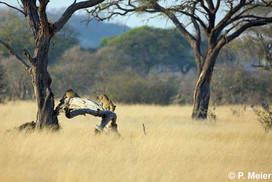
- Habitat of the leopard.
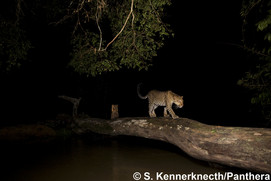
- Leopard in Gabon.
Ecology and Behaviour
The leopard is solitary and territorial. In prior studies in savannahs and woodlands, it was described as being mainly active between sunset and sunrise, but populations in undisturbed rainforest areas in Gabon were largely diurnal. It uses scent marks and vocalization to communicate and less frequently in some regions tree scratching to mark its territory. The leopard is a visual hunter in open habitats, and uses high points such as trees to locate prey. In such open habitats the leopard hunts by stalking from a very low position, with long periods of time resting motionless if needed. In dense tropical forests, the leopard predominantly seems to hunt from an ambush, targeting well-used game trails or fruiting trees that attract ungulate prey. It attacks from very close range with a short burst of speed and a powerful strike of the front paw. In a study in the Phinda Private Game Reserve, South Africa, leopards preferred hunting in habitats where prey was easier to catch rather than where prey was more abundant. The probability of making a kill was highest in habitats with intermediate cover. It is suggested that leopards select their prey in accordance with energy expenditures and may have a certain specialisation in regard of the habitat where they prefer to hunt as it seems that they do not only need high prey abundance, but as well appropriate vegetation cover to ensure successful hunting. Also in the Welgevonden Private Game Reserve, South Africa, female leopards showed a preference for hunting in mixed closed woodland and tall open woodland, and not for the grasslands where prey biomass estimates were highest. Forest leopards are mainly diurnal and crepuscular hunters following the activity patterns of their main prey species. The leopard is an excellent climber and prey species are often dragged up into trees for eating and caching in areas where leopard occur sympatrically with larger scavengers such as lions (Panthera leo) and spotted hyaenas (Crocuta crocuta). The leopard also retreats up a tree in the face of direct aggression from such competitors.
The home ranges of leopards in protected areas in Africa are approximately 30-78 km² (males) and 15-38 km² (females). In mountainous terrain the home ranges seem to be much larger with over 300 to 400 km². In the Mangwe area in Zimbabwe, the home range of one male reached 263 km² and that of two females 31 and 45 km². In Central Kalahari leopards were recorded to have home ranges of up to 2,182 km², whereas in Thailand a home range of only 8.8 km² was recorded for a female and 17.7 km² for two males. Home ranges of females and males generally overlap but home ranges amongst males do not or only to a very limited extent. Mean daily distance travelled in the Waterberg mountain area of Limpopo was 8.6 km (male) and 6.1 km (female); in Namibia and the Khalahari, distances were larger with mean daily values of 12.2 km and 14.3 km for males and 6.8 and 13.4 km for females respectively. Dispersal of leopards is generally sex biased: females are philopatric and males disperse over long distances away from their natal area. In southern Africa a subadult male leopard dispersed over a minimum distance of 352 km between his natal range and the site where he died. The sex ratio of resident adults is approximately 1m:1.8f.
Reproduction may take place throughout the year. In southern Africa, there may be birthing peaks during the birth season of the leopard’s main prey species, the impala. In the Sabi Sand Game Reserve, South Africa, litters were born in all months of the year but most females gave birth during the wet season, especially in December. In the Karongwe conservancy, South Africa, the estrus cycle was reported to be on average around 23 days, whereas in captivity, the mean inter-estrus period was found to be around 46 days. Age at first reproduction for females is on average 35 (24-46) months and for males 36-48 months. The interbirth interval averages 15 months to over 2 years. In the Sabi Sand Game Reserve, females gave birth on average 6 month after their previous litter became independent or 8 months after a litter was lost. Age at independence is 7-18 months. Siblings may remain together for several months before separating. The age at the last reproduction is on average 8.5 years but can take place up to the age of 16. There is one incidence known where a 15 year old female leopard adopted the 7 month old cub of her 9 year old daughter. This adoption event was most probably motivated by kin selection.
Cub mortality is quite high and varies between 50% to 90% in the first year. In the Kruger National Park annual subadult mortality was 32%, compared with an average mortality of adults of 19%. In the Phinda Private Game Reserve, mortality rate of juveniles was approximately 42%. Cub survival did not differ between male and female cubs nor depend on the season (dry, wet) of birth. Cub survival, however, seemed to be influenced by the mother’s age: cub survival decreased after females reached 9 years and dropped sharply after a female reached 14 years. Mortality rates of subadult leopards varied between sexes: males had a mortality rate of 29% and females one of 15%. Intra-specific strife caused most of the deaths followed by human-related mortality. Male mortality was mostly due to human activity and was significantly higher than the mortality rate of females, which mainly was caused by natural causes. High turnover rate of males can have a significant impact on the reproduction rate of a population. A high turnover could increase the likelihood of contact between unfamiliar individuals and thus promote intraspecific strife and increase infanticide. In Sabi Sand Game Reserve, male leopards were responsible for 40% of cub mortality. Infanticidal males were typically unrelated to their victims. Infanticide in leopards seems to mainly be an adaptive behaviour which provides reproductive benefits to perpetrators. If the unweaned offspring of a female was killed then the interbirth interval was shortened and the chance of the perpetrator to mate increased. Females on their side appear to adapt several strategies to minimize the risk of infanticide. It seems that the reproductive success of females is mainly regulated by top-down processes and it is suggested that infanticide is the key factor shaping the sociospatial ecology of leopards. Prey availability may play a larger role in cub mortality in less productive habitats or in populations below carrying capacity.
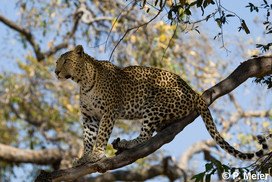
- Leopard in a tree, Namibia.
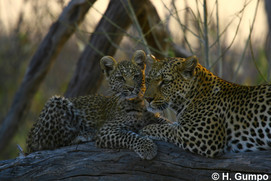
- Leopard with its cub.
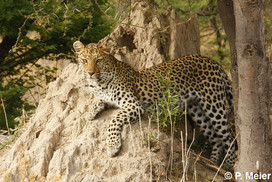
- A leopard looking out for prey.
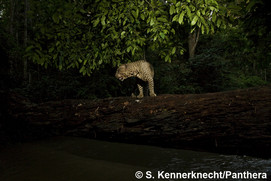
- African leopard in Gabon.
Prey
The leopard preys on a variety of mammalian species from large ungulates such as elands (Tragelaphus oryx) (males reaching 900 kg) to small species such as rock hyraxes (Procavia capensis) (4 kg). In sub-Saharan Africa, 92 prey species were documented. Leopards prey on, beside other species, impala (Aepyceros melampus), grey duiker (Sylvicapra grimmia), red duiker (Cephalophus natalensis), reedbuck (Redunca arundinum) and warthog (Phacochoerus aethiopicus). In the Comoé National Park, Côte d’Ivoire, leopards preyed mainly upon small to medium-sized ungulates with preference for duikers and bushbucks, but also took kob (Kobus kob) and oribi (Ourebia ourebi). Additionally, primates such as colobus monkeys and guenons, and large rodents were consumed beside. In the Lopé National Park, Gabon, the most important prey species (in regard of prey mass) was red river hog (Potamochoerus porcus) followed by forest buffalo (Syncerus caffer nanus) and cane rat (Thryonomys swinderianus). In the alpine zone of Mount Kenya, rock hyrax (Procavia capensis) was the most frequent prey species followed by grooved-toothed rats (Mylomys dybowskii). The leopard has an exceptional ability to adapt to changes in prey availability. However, the leopard prefers medium sized ungulates with a weight of 10-40 kg but can kill prey up to 2 or 3 times larger than itself. Small prey is mostly taken opportunistically, and primates, hares, rodents, large birds, pangolins and small carnivores can form an important part of its diet where large ungulates are less frequent.
In some parts of its range also domestic animals are an important part of its diet or even are the dominant prey.
The diet of leopards is influenced by many factors such as prey density and composition but also by other predators. Leopard predation is also affected by environmental factors such as vegetation cover, and anthropogenic pressure such as by overhunting of bushmeat.
The leopard’s ability to use trees for caching surplus meat enables them to coexist with lions and tigers, and to withstand pressure from scavengers.
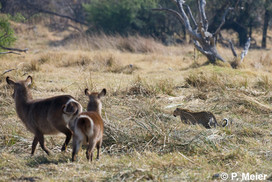
- Leopard and its prey species observing its movements.
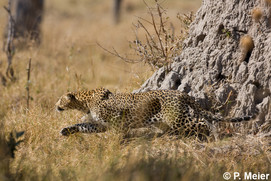
- Leopard hunting for prey.
Main Threats
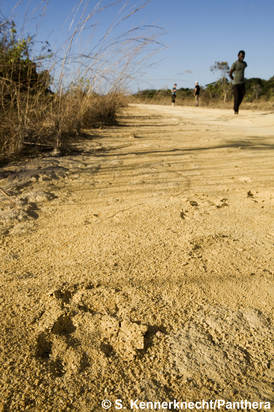
- Human-leopard conflicts are one of several threats affecting the leopard.
The main threats to the leopard are of anthropogenic origin. Continuing persecution by humans, habitat loss and fragmentation, prey base declines, illegal wildlife trade, retaliatory killing and poorly managed trophy hunting are the main problems leading to leopard reductions.
Human populations expand and natural habitat is converted to urban landscape, into agricultural fields or livestock farms. The expansion of ranch land for livestock breeding not only impacts the habitat of leopards but can also depress wild ungulate populations on which the leopard depends. Moreover, overhunting of its prey is negatively affecting the species. For example, in the African forests the bushmeat trade has resulted in the so called “empty forest syndrome” which means that the forest habitats remain quite intact but that the prey spieces have been highly reduced. This is also taking place across large areas of savanna Africa, resulting in collapses in prey populations.
Conflicts between leopards and humans occur across its range. Illegal killing, mostly as retribution for livestock or game predation, is a significant problem. Mainly in southern Africa, the predation on valuable game animals leads to retaliation killing of leopards. Moreover, in many countries of sub-Saharan Africa, farmers are allowed to kill predators which are considered a threat to life and property. Permits are often distributed retroactively.
A rapidly increasing threat is also the poisoning of carcasses either as means of predator control or incidentally. The leopard is particularly vulnerable to baited trapping as it patrols small home ranges along regularly used trails. Diseases such as rabies, canine distemper and bovine tuberculosis can also be a threat to the leopard.
In some parts of its range the leopard is legally hunted as a trophy species. The impact of this hunting is not fully clear. There is a need for further research on harvest quotas and hunting practices. However, poorly managed trophy hunting can be determinental to leopard populations. Unsustainable hunting activities and uneven distribution of hunting effort were shown to lead to high mortality rates and low recruitment rates in leopard populations. Overhunting of males can lower female reproductive output, as turnover in resident males can lead to increased rates of infanticide and reduced rates of conception.
In other areas, poaching of leopards is quite common. The fur trade was a major threat to the leopard in some areas during the 1960s and 1970s, before the market collapsed due to changing public opinion and the imposition of international trade controls under CITES. However, leopards are still poached for the skin trade and traditional medicines in many African countries, mainly for the domestic markets. Skins and canines are still widely traded. Formerly predominantly used locally in traditional rituals, skins and canines are now sold openly in villages and urban markets to foreign workers and military personnel. In Africa alone some 4,500-7,000 leopards are killed each year only to meet the demand for leopard skins by followers of the Nazareth Babtist (Shembe) Church.
If the leopard is provided with a minimum of suitable habitat cover, enough prey, and is not persecuted, it is fairly tolerant of habitat alterations and can even persist close to human populations due to its adaptive behaviour. However, leopards have still a limited level of ecological resilience to human-caused habitat fragmetnation and thus are more restricted to conservation areas. Generally, leopards require large contiguous habitats with low human impacts to reproduce successfully. In the African rainforests leopards seem to exhibit a strong functional and numerical response to competition with human hunters for prey and leopards are absent close to settlements where hunting activities are highest.
Conservation Efforts and Protection Status
The leopard is included in the Appendix I of CITES. It is largely protected across its range. Hunting is prohibited or restricted to “problem” animals in Angola, Algeria, Benin, Burkina Faso, Cameroon, Congo, Côte d'Ivoire, Democratic Republic of Congo, Djibouti, Egypt, Equatorial Guinea, Gabon, Ghana, Guinea Bissau, Liberia, Mali, Mauritania, Morocco, Niger, Nigeria, Rwanda, Senegal, Sierra Leone, Somalia, South Sudan, Togo and Uganda. Killing “problem” leopards occurs and is generally permitted. The legal international traffic is limited to an annual quota for export of sport hunting skins and trophies. Trade in leopard skins is restricted to 2,560 individuals in 11 countries in sub-Saharan Africa. There is no legal protection in Gambia, Lebanon, Tunisia and the United Arab Emirates. No information is available for Burundi, Chad, Guinea and Libya.
Throughout its range it is important to reduce the source of conflict between human and leopards. Compensation procedures for depredated livestock and improved livestock husbandry practices and management measures, reducing the risk of depredation, are important as they can increase the tolerance of people towards leopards and thus reduce the conflict. Moreover, raising public awareness, involving local inhabitants and establishing protected areas help to ensure the survival of the leopard. Translocation or removal of problem animals does not address the source of the problem and does not seem to be a suitable mitigation of such conflicts in the long term, sometimes, even aggravating the situation. Additionally, habitat fragmentation and loss should be mitigated as much as possible. In Africa, most of the leopards live outside protected areas and mortality rates of leopards are much higher in border areas or outside of protected areas. Therefore, it is important to increase the size of such areas and to take conservation measures outside of protected regions. Thus, human activities must be addressed on both sides of reserves to assure the long term survival of leopards.
In areas where leopards are subject to hunting or persecution, it is important to include numerical and functional components of their population dynamics into account when doing conservation work. Activities such as trophy hunting that may artificially elevate turnover among breeding males may increase rates of infanticide to unsustainable levels. It must be assured that trophy hunting takes place in a sustainable way and is well managed. It was indicated, that an age-based hunting approach seems practically applicable for leopards as it is possible to identify the age of leopards at sight. A safe harvest is more likely if hunting is restricted to male leopards over 7 years, when they are old enough to have reared their first cohort of offspring to independence. Alternatively, quotas should be reduced to conservative levels. An effort should be made to ensure hunting pressure is equitably distributed throughout available leopard range based on ecological boundaries rather than administrative ones. Moreover, in order to hunt leopard populations sustainably, robust density estimates are needed as well as thorough monitoring programmes to assure a sustainable harvest without harming the population. To adress the killing of leopards for their furs used in traditional ceremonies, conservationists in South Africa have partnerd with textile companies and communitites to provide faux-fur alternatives.
Namibia conducted an assessment of trophy hunting. Zambia placed a moratorium on leopard and lion hunting in 2013. In South Africa, Mozambique and Botswana, researchers have developed regional studies of the hunting quota system. Beside others, trophy quality and geographical distribution of permits were analysed and measures suggested. In 2014, sport hunting has been banned in Botswana and South Africa placed a moratorium on leopard trophy hunting for the year 2016.
